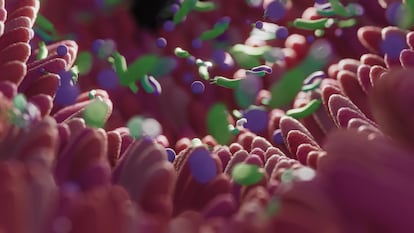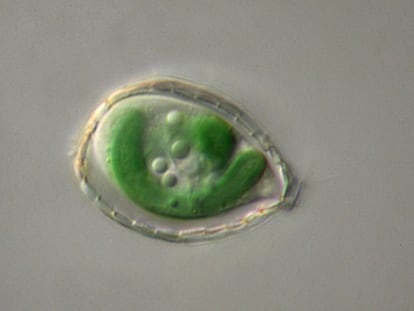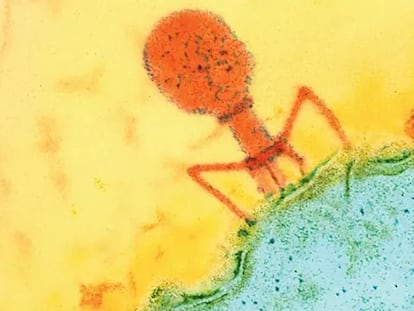‘We are half human, half bacteria’: What the microbes in our bodies can do for us
The microbiome is a protective barrier against external pathogens that modulates the immune system and helps metabolize food. But it has additional hidden functions, and the scientific community is investigating its role in health and disease

We are not alone, not completely. We are always accompanied by thousands of bacteria, viruses, fungi and yeasts, archaea and protozoa, which are invisible to the naked eye and go unnoticed. This immense living world of microbes relatively harmoniously populates the skin, the vagina, the mouth, the lungs and, especially, the intestine, to help the human body perform elementary functions, such as protecting it against external pathogens and metabolizing certain foods. All together, they are known as the human microbiome, a complex ecosystem of microbes that functions as another organ in the body. Scientists already know some of the microbiome’s essential tasks, but researchers are still trying to gain a better sense of the microbes’ role in health and disease: they are studying changes in this microworld that have to do with infectious diseases, autoimmune diseases and even responses to oncological drugs.
As microbiologist Ignacio López-Goñi puts it, a person is “half human, half bacterium.” That is, the body has as many microbes of this type as it does human cells. “We have about 23,000 human genes but, as a whole, our microbes may harbor some 3 million genes. Some already consider this microbiome to be our second genome. We are superorganisms in which 1% of our genome is inherited from our parents and 99% from our microbes,” he synthesizes in his book Microbiota: Los microbios de tu organismo [Microbiota: Your Body’s Microbes] (Almuzara, 2018).
Of all the tiny microorganisms that roam freely in the body, bacteria are the most common ones in what is called the microbiota or microbiome. Some experts use the terms interchangeably, but there’s a nuanced difference between the two: the former refers to the community of microbes and the latter to the genes within them. “It is estimated that the healthy body is inhabited by over 10,000 different
bacterial species, of which less than 1% are potential pathogens,” López-Goñi writes in his book. The mouth and intestinal tract have the most diverse bacteria.
The scientific community has been working to determine what this amalgam of microbes living inside humans does and how it is organized. Although scientists have found out some things, there is still a great deal that they have to learn, says Jordi Guardiola, the head of the Digestive System Service at Barcelona’s Hospital de Bellvitge and one of the directors of the Unit for the Study of the Microbiome at that hospital: “The main thing we know is that we know very little: the microbiome is extremely complex.” José Manuel Fernández-Real, a scientist at the Josep Trueta Biomedical Research Institute of Girona, likens the microbiota to the black box of an airplane; it is “a continuous record of daily activity,” from food to stress level and mood. “It is an enormous volume of information that we have to unravel,” admits the expert, who is also a scientist at the Center for Biomedical Research Network on Obesity and Nutrition.
Each microbiome is unique; no two are the same, and they are constantly changing with age, habits, diet and medication. There are about 150 dominant bacterial species, notes Francisco Guarner, a gastroenterologist and a member of the International Human Microbiome Consortium’s scientific committee. “One study showed that there were only 18 species that existed in all participants, but for some it was on the order of 1 and, for others, on the order of 10,000. We could not define the essential core of bacteria. They were not random mixtures but living ecosystems. And [the microbiome] changes a lot: it is not static, but it is stable; there is always…a balance among bacteria.”
The intestinal microbiota is the most studied, because it is the largest and most varied area, and it has the most key organic functions. Guarner explains the intestinal microbiota’s crucial role: “The colon [is] prepared to receive bacteria, and we want [bacteria] to be there to help us digest food. The colon has a pouch, the cecum, into which what[ever] the pancreas could not absorb are deposited. Vegetable cells, for example, are digested by bacteria in the cecum.”
Stimulating the immune system
The intestinal microbiota is also “an important filter of the external environment,” says Fernández-Real: “It is a marker of the diet we eat, a transformer of many substances – [it acts] like a liver before the liver – and it is also a sort of immune system that protects us from foreign elements.” In fact, Guardiola adds, another function is stimulating the immune system: “Microbes relate to each other and to us. There’s a constant conversation. In the first years of life, it is essential to have a microbiome so that the immune system develops normally.”
The microbiome is influenced by diet, medications, smoking, physical exercise and diseases. For example, the use of antibiotics in early childhood can be a risk factor that alters that microbial balance. “The price we have to pay for not dying of infections is that immune-mediated diseases can emerge. Most of the genetic variants detected as risk factors for these diseases are genes that encode aspects related to the microbiota,” says Guardiola. Birth by cesarean section, and the concomitant lack of immersion in the mother’s vaginal microbiome, raises the risk of asthma and allergies; breastfeeding also influences the composition of a child’s microbiota and is key to building his or her immune system. Experts point out that disturbances in the microbiota’s development during the immune system’s maturation process could impair immune tolerance and lead to autoimmune diseases.
The scientific community has been focused on finding out what exactly the microbiome’s role is in healthy versus sick individuals. Does the alteration of the microbiome lead to disease, or does disease modulate the microbial ecosystem? Probably both. Researchers are beginning to delineate how these microorganisms mediate various pathologies, but it is not easy to narrow down their influence. “Surely, the microbiota is another factor that we did not count on, but it’s not necessarily the decisive factor,” says Guarner.
The gastroenterologist explains that we do know for certain that these microbes influence “colon and breast cancer, depression, allergies, obesity, type 2 diabetes and ulcerative colitis” to some extent. As Guarner points out, “the common factor…in almost all diseases is the loss of diversity [in the microbiota], which is possibly also related to protein- and fat-rich diets [that include] few vegetables. The microbiota that we had in the colon to digest those vegetables is lost and disappears.”
Studies conducted on mice also suggest that the gut microbiota can influence neurophysiology, behavior and even the process of healing wounds. The study also found that the gut microbiota can affect cognition and anxiety. Other research, also performed on animals, indicated the potential relevance of gut microbes in neurodegenerative diseases, such as Parkinson’s, and found that “there is a significant difference in the gut microbial component of children who have disorders on the autism spectrum and those who do not.” Periodontal diseases, which are spread by a change in the oral microbiota, also raise the risk of cardiovascular disease by up to 25%.
In cases of cancer, the alteration of the microbiota can trigger inflammation and an immune response related to the onset of tumors. Guardiola explains that researchers are also studying whether or not a certain microbiota can predispose a person to a tumor. For the time being, he adds, “[research] has found a very clear relationship between the microbiome and the possibility of responding to immunotherapy…The microbiota of patients who respond to immunotherapy differs from that of patients who do not respond. If you apply this to experimental animals and put feces from patients who do respond into the non-responding mice, they will eventually respond as well. The microbiota has the ability to influence these treatments and can be used as a prognostic factor and as a treatment: there are studies of fecal [microbiota] transplants for immunotherapy.”
Fecal microbiota transplantation
An ailment closely associated with the microbiota is Clostridium difficile infection, a highly resistant bacterium. In weakened individuals, it can cause mild colitis (diarrhea) or severe colitis, which can lead to the potentially fatal toxic megacolon. This disease is so clearly related to an alteration of the microbiota that transplanting fecal microbiota from a donor is the indicated treatment for patients who do not respond to conventional therapies. “In 20% of patients, the infection recurs. The possibility of recurrence then rises to 40%,” says Guardiola, who performs about 20 such transplants each year at his hospital.
The study of the microbiota has explored different aspects, from describing it to understanding its function to learning how to modulate it for therapeutic purposes. In the latter area, stool transplantation, which repopulates the patient’s intestine with fecal microbiota from a healthy donor, has been one of the most promising strategies. So far, however, the procedure has only been successful for Clostridium difficile infections. Guarner notes that it did not function as well for irritable bowel syndrome. “In a disease, there’s a lack of some species and an overabundance of others. When you take
stool from a donor, you transplant some good bacteria and some bad and, perhaps, the good ones do not fit well in that inflamed intestine and the bad ones do, so the inflammation increases. This has happened in ulcerative colitis [cases], where some transplants went well, and others did not. The problem is that you introduce a world of many unknown bacteria, and a patient’s particular situation may mean that some of them do not fit well.”
Guardiola, who established a stool bank at his hospital, agrees that fecal microbiota transplantation is “a necessity” for treating Clostridium difficile, but “it has not [worked] as well as predicted in other areas,” like inflammatory bowel disease. However, research continues to be done, including studies of bacterial cocktails “designed in the laboratory and perfectly identified so that there are no surprises” with potentially unknown microbes, Guarner says. In November, the US Food and Drug Administration (FDA) approved the first pre-packaged fecal microbiota biopharmaceutical to treat Clostridium difficile.
In the laboratory, scientists are also experimenting with modified bacteria to modulate the microbiota, and they continue to test probiotics and prebiotics, although the efficacy of the latter two remains low and highly controversial. “Probiotics are an attractive idea, but in clinical practice we achieve almost nothing [with them],” concludes Guardiola. Fernández-Real agrees: “Talking about probiotics [as a way] to try to change [a person’s] health is complicated. It’s like trying to move an aircraft carrier with a handful of flies.”
The Mediterranean diet
Research on the microbiome is ongoing. But at the therapeutic level, the experts we consulted advocate eating a Mediterranean diet, which is known to have a positive effect. “People who follow it have the closest thing we know to a healthy microbiome,” Fernández-Real notes. Guarner agrees: “We must recover the microbiota’s functionality, return to ancestral diets, [and] eat lentils, peppers and eggplants.”
The experts admit that there’s still a world of information about the microbiome’s complexities that remain to be discovered. For example, Guarner points out that we lack information about the role viruses play in this intricate ecosystem: “The virome is the most unknown [area]. Thirty-five thousand viruses have been found in the intestine: 98% are viruses that affect bacteria, not human cells, and of these, we do not know what 75% of them do.”
For that reason, experts don’t even know what, exactly, “the definition of a healthy microbiome” is, Fernández-Real laments. Nor do they know the extent of the microbiome’s role. “It’s difficult to say when [the microbiota] lacks influence. What we can say with certainty is that over the last 70 years the microbiota has atrophied a lot. It has become atrophic through changing nutritional patterns and the use of antibiotics,” says Guarner.
A great deal of work remains to be done, such as gaining a “better understanding [of] the mechanisms by which the microbiota and the immune system communicate with each other,” says Guardiola. Guarner argues that “the key will be detecting critical deviations in the intestinal microbiome and finding ways to correct them.” For his part, Fernández-Real proposes a different approach: “We should not try to change the bacteria but rather their function because they will remain with us.”
Sign up for our weekly newsletter to get more English-language news coverage from EL PAÍS USA Edition
Tu suscripción se está usando en otro dispositivo
¿Quieres añadir otro usuario a tu suscripción?
Si continúas leyendo en este dispositivo, no se podrá leer en el otro.
FlechaTu suscripción se está usando en otro dispositivo y solo puedes acceder a EL PAÍS desde un dispositivo a la vez.
Si quieres compartir tu cuenta, cambia tu suscripción a la modalidad Premium, así podrás añadir otro usuario. Cada uno accederá con su propia cuenta de email, lo que os permitirá personalizar vuestra experiencia en EL PAÍS.
¿Tienes una suscripción de empresa? Accede aquí para contratar más cuentas.
En el caso de no saber quién está usando tu cuenta, te recomendamos cambiar tu contraseña aquí.
Si decides continuar compartiendo tu cuenta, este mensaje se mostrará en tu dispositivo y en el de la otra persona que está usando tu cuenta de forma indefinida, afectando a tu experiencia de lectura. Puedes consultar aquí los términos y condiciones de la suscripción digital.
More information
Últimas noticias
Pinochet’s victims grapple with José Antonio Kast’s rise in Chile
Reinhard Genzel, Nobel laureate in physics: ‘One-minute videos will never give you the truth’
How Japan is trying to avert ‘digital defeat’
The complicated life of Francesca Albanese: A rising figure in Italy but barred from every bank by Trump’s sanctions
Most viewed
- Pablo Escobar’s hippos: A serious environmental problem, 40 years on
- Why we lost the habit of sleeping in two segments and how that changed our sense of time
- Charles Dubouloz, mountaineering star, retires at 36 with a farewell tour inspired by Walter Bonatti
- Trump’s obsession with putting his name on everything is unprecedented in the United States
- The Florida Keys tourist paradise is besieged by immigration agents: ‘We’ve never seen anything like this’











































